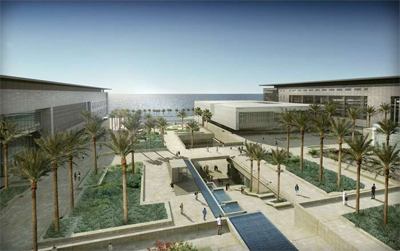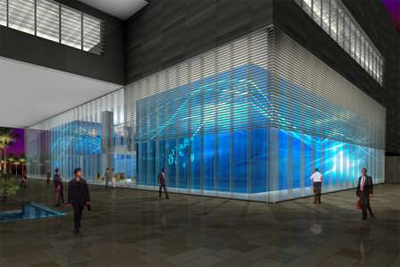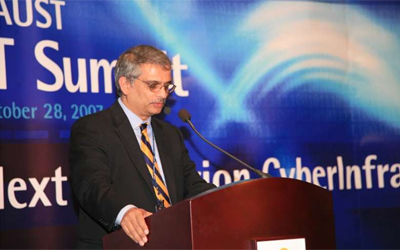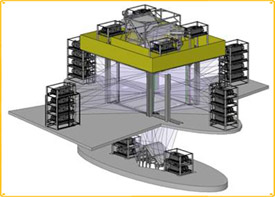Saudi University Announces Special Partnership with Technology Institute at UC San Diego
Calit2 Collaborates on Facilities for Researchers Developing Technologies to Benefit Society
San Diego and Jeddah, Saudi Arabia, Oct. 14, 2008 -- King Abdullah University of Science and Technology (KAUST) and the University of California, San Diego today announced a special partnership to collaborate on world-class visualization and virtual reality research and training activities. The Geometric Modeling and Scientific Visualization Research Center (GM&SVRC) is expected to enhance research in areas ranging from solar power to clean water and new medicines.
|
Under the four-year agreement, the UC San Diego division of the California Institute for Telecommunications and Information Technology (Calit2) will provide expertise in visualization, virtual-reality and collaboration tools to support KAUST’s ambitious plan to deploy state-of-the-art technologies for scientific research.
The technologies will allow materials scientists, biomedical researchers, electrical engineers and other researchers to speed development of new technologies. The partnership will also enable collaboration between researchers at KAUST and UC San Diego, whose visualization facilities will eventually be linked via very high-speed networking.
Calit2’s development of visualization and collaboration facilities has attracted worldwide attention. The partnership with KAUST will expand the network of elite academic institutions that have access to ultra-high-resolution display and collaboration facilities.
|
“As one of the youngest top-tier U.S. universities in science and technology, UC San Diego has a particular affinity with the ambitious challenge facing KAUST,” said UCSD Vice Chancellor Steven W. Relyea, who is scheduled to represent the university at a meeting in Jeddah , Saudi Arabia, on Oct. 15 and 16, at a KAUST-hosted meeting of special academic research partners.
|
Calit2's development of the world's best visualization and collaboration facilities has attracted global attention and admiration. GM&SVRC will build on and expand Calit2's network of elite academic institutions, providing access to ultra-high-resolution display and collaboration facilities.
About a dozen researchers from Calit2 will prototype and evaluate appropriate technologies for use on the KAUST campus. These will be deployed first in the Al-Khawarzimi Mathematical and Computer Sciences and Engineering Building,
a shared-use facility at the core of the new campus. Over time, the visualization tools, displays and services will expand to other parts of the campus and even to its research partners in Europe, Asia, the Americas and the Middle East.
|
|
The proposed KAUST GM&SVRC will be the world's-best visualization suite. When ready in September 2009, this research facility will host both the world's highest VL6 resolution and brightest virtual environment, and a world-class Multipurpose Room. One such project of the GM&SVRC is to develop a virtual environment for the interactive visual exploration of Saudi Arabia, providing examination of 3D geological structures and dynamic seismic processes as well as atmospheric processes and effects or built or planned infrastructure. The specific techniques required to support such functionality will be integrated into a generic infrastructure for visual computing, allowing essentially all KAUST Research Centers to use parts of this functionality in
other applications.
KAUST's GM&SVRC will be supported by proposed developmental systems that will allow unprecedented flexibility for the researcher/developer to design applications for the world-class facility without tying up larger systems. The GM&SVRC will be enhanced with the ability to record signals/sessions from each of the displays digitally in high-definition. This approach will set the KAUST GM&SVRC apart and catapult it beyond visualization suites anywhere in the world. A state-of-the-art spatial audio system would be the first of its kind and would make the KAUST GM&SVRC the world's only known research center for this type of audio system. This system is to be designed in collaboration with Meyer Sound and UC San Diego, recognized as world leaders in this technology.
Specifically, the Visualization Cluster within The GM&SVRC will go beyond other international systems through its use of the GraphStream visualization cluster. GraphStream components decrease the physical footprint and reduce the power utilized while gaining the compute power needed to run a best-in-world visualization suite.
About KAUST
King Abdullah University of Science and Technology (KAUST) is being built in Saudi Arabia as an international, graduate-level research university dedicated to inspiring a new age of scientific achievement in the Kingdom, the region and around the globe.
As an independent, merit-based institution, KAUST will employ many of the best practices from leading research universities and enable top researchers from around the globe and across all cultures to work together to solve challenging scientific and technological issues. The KAUST global research and education network will support diverse talents, both on its campus and at other premier universities and research institutions, through collaborative research agreements, grants, and student scholarship programs.
KAUST will be merit-based, open to men and women from all cultures around the world, and governed by an independent, self-perpetuating Board of Trustees. The core campus, located on more than 36 million square meters on the Red Sea at Thuwal, is set to open in September 2009.
For more information about KAUST, visit www.kaust.edu.sa.
About Calit2 at UC San Diego
The UC San Diego Division of the California Institute for Telecommunications and Information Technology (Calit2), together with Calit2’s division at UC Irvine, house over 1,000 researchers across the two campuses, organized around more than 50 projects on the future of telecommunications and information technology and how these technologies will transform a range of applications important to the California economy and its citizens' quality of life.
Created in 2000 by the State of California to maintain and extend its leadership in critical technologies, Calit2 brings together teams of faculty, student and staff researchers on both campuses with leading California telecommunications, computer, software, and applications companies. They conduct studies in “living laboratories” to investigate how the future Internet will accelerate advances in areas such as environmental science, civil infrastructure, intelligent transportation and telematics, genomic medicine, new media arts and digital cinema.
For more information about Calit2, visit www.calit2.net.
Related Links
KAUST
Media Contacts
Doug Ramsey, 858-822-5825, dramsey@ucsd.edu or Jeff Weintraub, 202-828-8836, media@kaust.edu.sa






